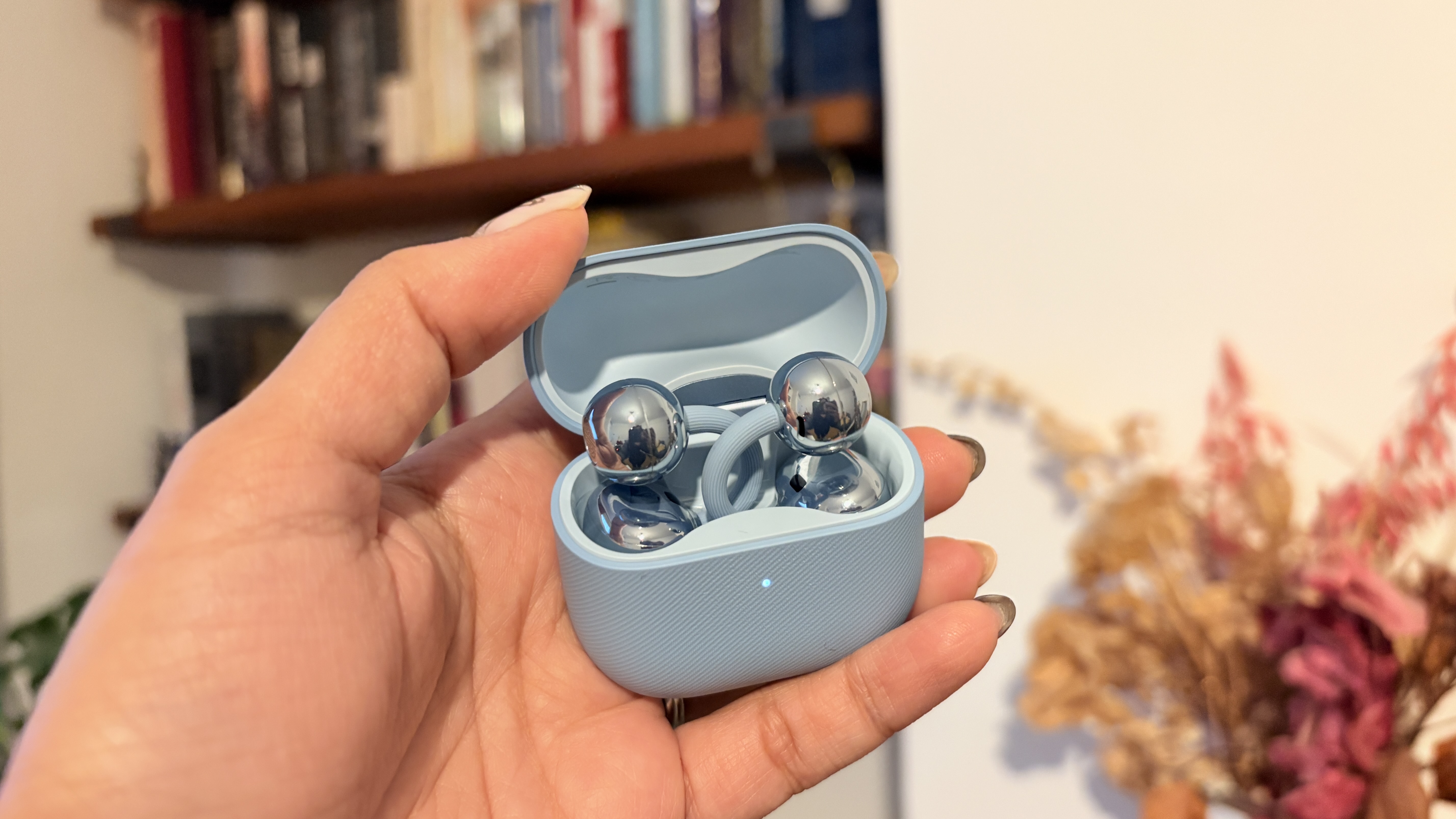
Bowers and Wilkins (B&W) is one of the biggest names in hi-fi and for good reason, since the firm started making audio products in the seaside town of Worthing UK all the way back in 1966, it has made a steady stream of amazing products.
And, while we can’t claim to have tested every single one of them, with What Hi-Fi? launching a tiny bit later than B&W in 1976, we’ve done our honest best since then.
As a result if you go through our back catalogue you’ll see a sea of B&W reviews, many of which featuring our hallowed five-star rating.
However, of this list a select few hold an extra special place not just in hi-fi, but our history. And it’s these iconic items that are detailed in this list chronicling the best Bowers and Wilkins products of all time.
B&W DM110

We start with a relatively affordable speaker, the DM110 (£110 when we reviewed them in June 1984, so around £300 in today's money). These speakers sported a black chipboard cabinet with a silver baffle, a 32mm soft dome tweeter and a 50mm paper mid/bass driver. We described it as, "a mass produced speaker made in very large quantities for export", which sounded then, strangely, like a criticism, but with B&W now shifting large numbers of speakers all over the world, it was something of a trailblazer. Certainly, "powerful yet easy going" with a "striking, stylish finish", successfully set the tone for test verdicts that would apply to B&W speakers for many years to come.
B&W Matrix 805V
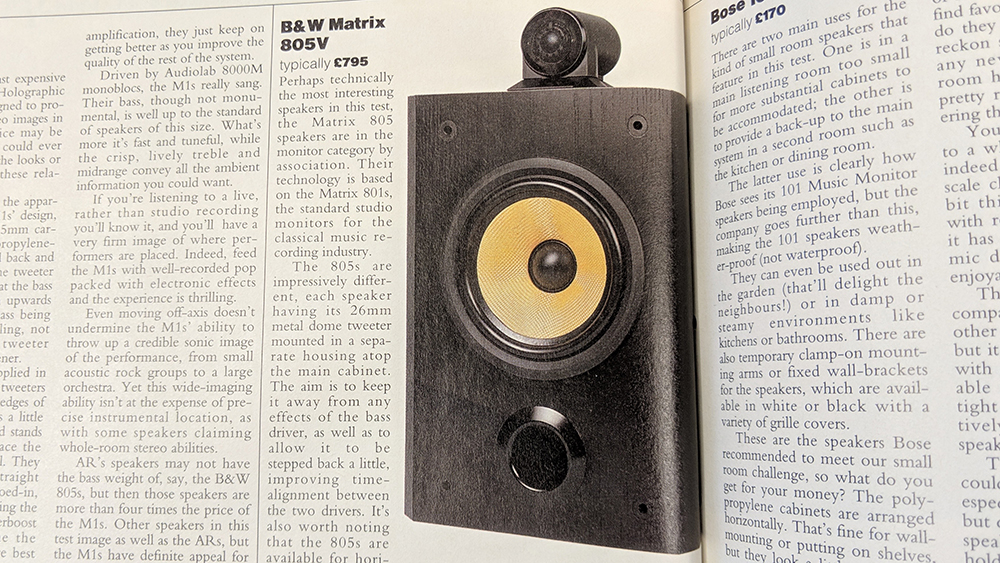
The Matrix 805V speakers saw a 26mm metal dome tweeter placed on top of the speaker cabinet above a yellow 165mm Kevlar cone, two design features that were soon to become synonymous with B&W. Inside the speakers a honeycomb-style bracing construction aimed to remove all unwanted resonance and reflections; the design giving the speaker range its Matrix name. And it was a design theory B&W revisited with future speakers, including its T7 portable speaker. We said that the Matrix 805V speakers "squeeze a huge sound out of small boxes", which made them a hit with us, despite their relatively high price tag (£795, back in 1992).
B&W CDM1
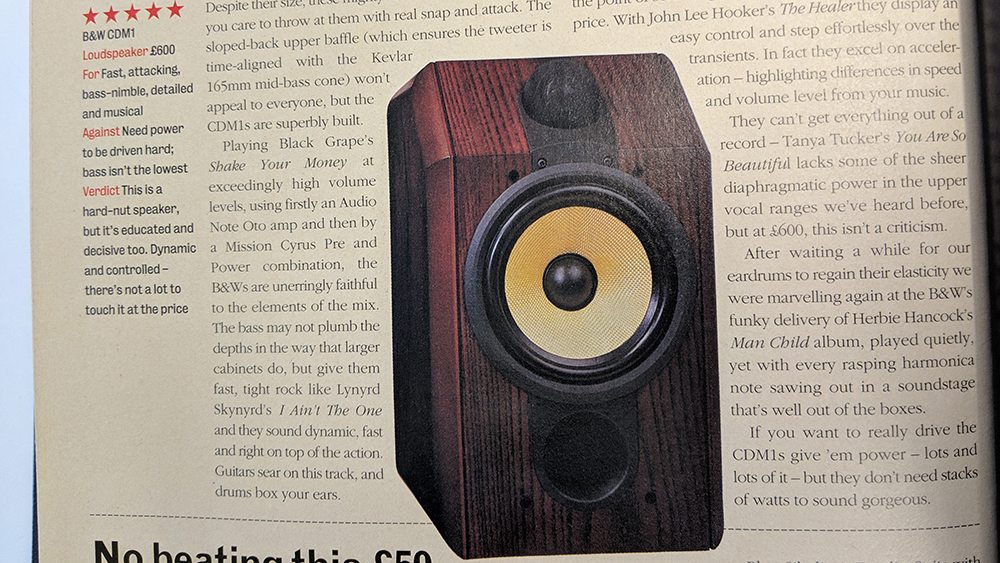
"This is a hard-nut speaker, but it's educated and decisive too. Dynamic and controlled – there's not a lot to touch it at the price." That's how we described the CDM1 speakers back in 1995. They too featured a 165mm yellow Kevlar cone but interestingly opted for a sloped baffle where the tweeter was housed, a tweeter that was derived from the one found on the Matrix series. We're pleased to see we reviewed these speakers by "playing Black Grape's Shake Your Money at exceedingly high volume", so not much has changed there.
The latest hi-fi, home cinema and tech news, reviews, buying advice and deals, direct to your inbox.
B&W Signature 30
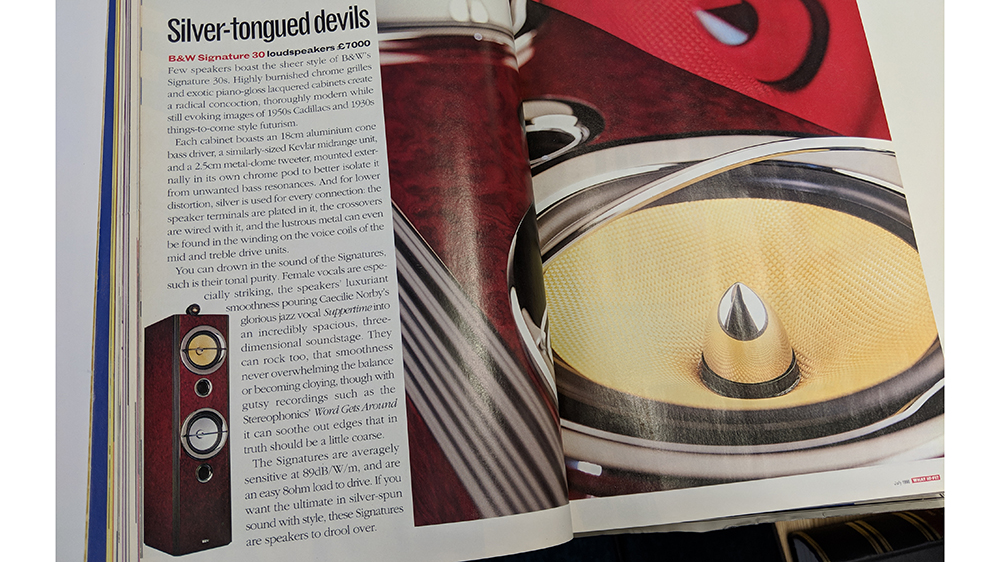
These £7000 B&W speakers found themselves in our July 1998 Temptation section. And very tempting they were, too. That isolated tweeter is back alongside a hefty Kevlar midrange driver and an aluminium bass cone. The Signature series were limited edition speakers, with pure silver wiring as their pièce de résistance. Driver leads, internal wires, voice coils and crossover wiring were all silver, which B&W engineers had decided were the optimum conductors for top-end speaker drivers. We didn't argue, heralding the Signature 30 speakers as "the ultimate in silver-spun sound with style".
B&W Nautilus 801

"If the price isn't an issue - nothing", was the sum total of our Nautilus 801 review of January 1999. "Simply awesome." These 801s borrowed technology from the company's flagship Nautilus speakers, which quickly planted themselves at number one on many people's ultimate speaker wish list. You needed to part with £8500 rather than £35,000 for this version, which borrowed the tapered tube enclosure for the midrange and treble drivers that aimed to minimise the diffraction caused by the cabinet. The Kevlar driver (a monster 38cm unit) and Matrix bracing is here, too, as B&W began to focus its technological attentions. The result here is accuracy and pure transparency in great big spades.
B&W DM602 S2
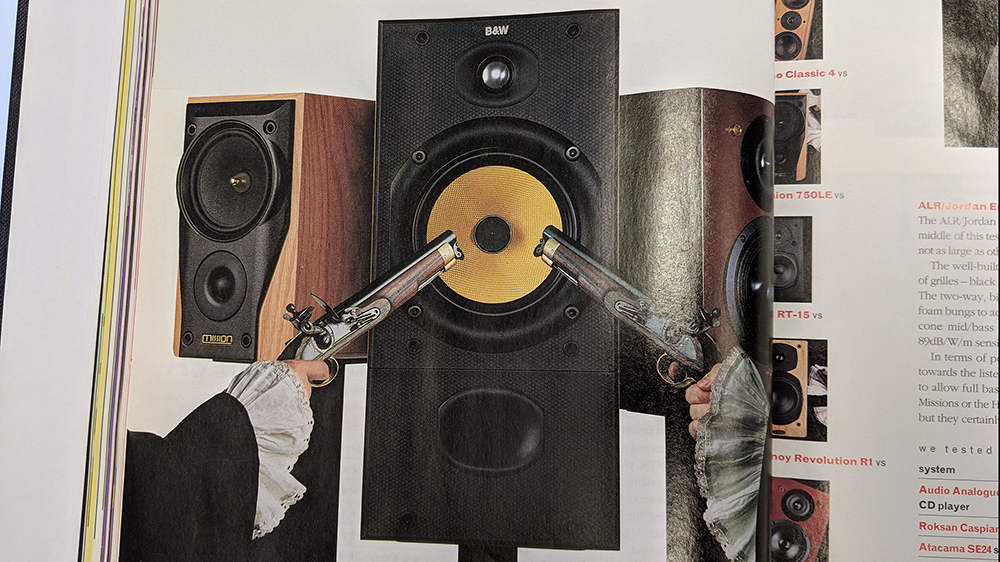
The Series 2 version of the B&W DM602 speakers appeared in our July 1999 speaker "shootout" - hence the slightly strange picture - and proved brilliant value for money, not least in terms of sheer cabinet size. That large box means plenty of bass, alongside a transparent and detailed midrange (OK, and a slightly forward treble). The DM602s were consistent performers over the years but it was the Series 2 and Series 3 models that really took them to the next level.
MORE: That Was Then... B&W 602 S3 review
B&W DM601 S3

We've opted for Series 3 as our favourite version of the DM601 speakers, though again we could have opted for pretty much any model. These speakers, reviewed in March 2002, were famously described as having "voice coils of the Gods" by one What Hi-Fi? reviewer, such was the impression they made in our test rooms.
The basic ingredients are unchanged here, with the Kevlar-coned mid/bass driver, alloy-dome tweeter and tapered internal tube. Various tweaks and upgrades around the driver and cabinet helped lift these B&Ws to new heights and beat-off opposition at its £249 (March 2003) price tag: "Stunning speakers with a formidable array of strengths."
B&W PV1

First reviewed back in November 2004, the B&W PV1 active subwoofer won seven What Hi-Fi? Awards in a row. Need we go on? OK, well firstly, check out how cool it looks. Secondly, understand the smart spherical design is for performance reasons, promising to deliver "the Holy Grail of subwoofer design: deep and clean bass from a near-invisible box". The PV1 uses two 20cm drivers in an opposed, in-phase array powered by a 500-watt Class-D amplifier. The results are sensational: almost zero resonance but stunning speed and power, and a remarkable sub that rocked our world - and our test rooms - for the best part of a decade.
Read the full B&W PV1 review
B&W 805S
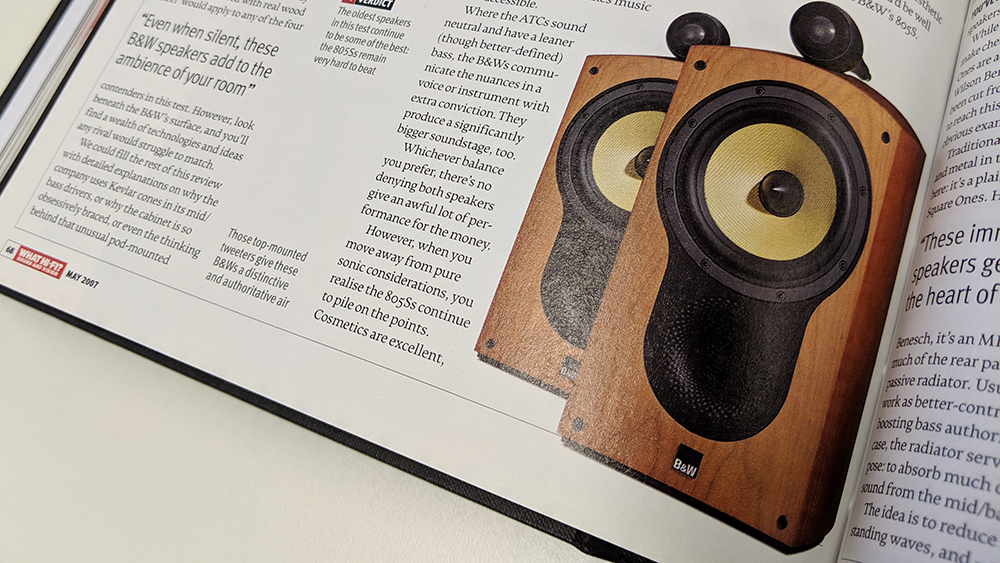
Another classic B&W speaker design, this time as featured in our May 2007 review. The pod-mounted metal dome tweeter, the Kevlar cone, the braced cabinet; the 805S speakers have the full suite of Bowers & Wilkins speaker technologies. They sound even better than they look, with a room-filling soundstage that's balanced and detailed. Even at £1600, they were Award-winning value for every penny.
Read the full B&W 805S review
B&W Zeppelin
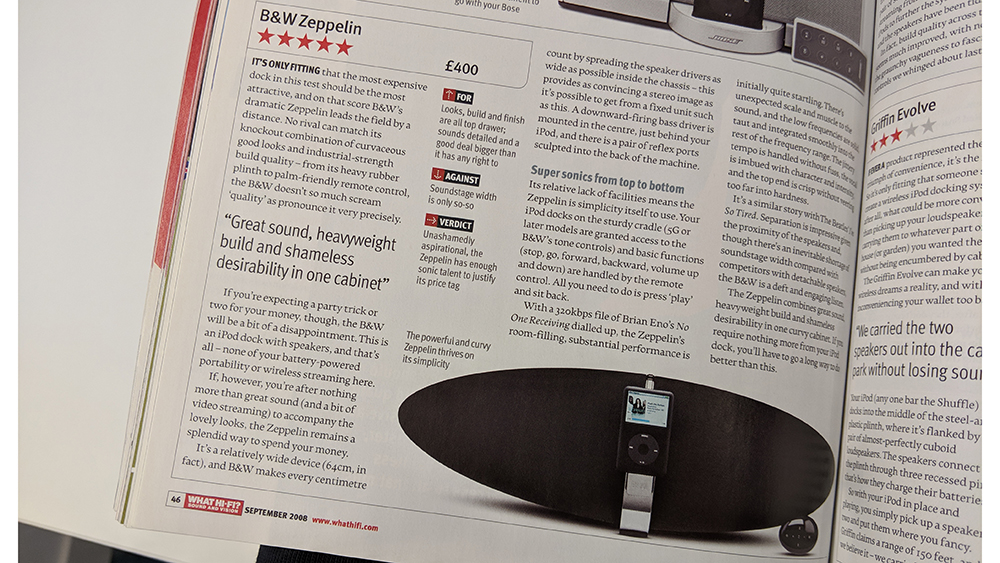
Making a great-sounding iPod dock wasn't as easy as it might sound (see Apple's three-star iPod Hi-Fi), which made the B&W Zeppelin (pictured here in our review from September 2008) all the more impressive. Another striking B&W design, you needed to clear a fair amount of desk space but were then treated to a detailed, spacious sound from your centrally-mounted iPod. In what would be a sign of things to come, B&W had successfully entered a new product category with another sweet marriage of stylish design and sound quality.
Read the full B&W Zeppelin review
B&W MM1

"PC Audio" sounds somewhat dated nowadays but the MM-1s were essentially a very good pair of desktop speakers - "edging towards proper hi-fi" as we phrased it, perhaps in one of our harder-to-please moods. At £399 (June, 2010), these speakers weren't cheap but they delivered a level of sound almost in spite of their size (just 17cm tall) to comfortably justify their price. Yet again, B&W had turned its hand to something new and knocked it out of the park.
Read the full B&W MM-1 review
B&W P7

Did we mention B&W turning its hand to something new and knocking it out of the park? It was the same story when it came to headphones. While the first B&W P3 and P5 headphones were good but perhaps not great, we were fully bowled-over by the big-boy P7s (and then later, the Series 2 smaller cans). All the headphones shared a similar sleek design, could fold-up for easy portability, were comfortable and, crucially, delivered a sound with impact, insight and impressive scale.
Read the full B&W P7 review
B&W MT-50

And it's not only stereo speakers (and subs, headphones and desktop speakers...), B&W had a decent run in the world of sub-sat speaker packages back when sub-sat speaker packages were still a thing. Despite not relying on the formidable PV1 subwoofer for its solid foundations, the MT-50 delivered a dynamic, detailed and authoritative performance that was hard to beat for the money (£1095) for many years. The M-1 satellites formed an integral part of a few more great little B&W cinema systems, such as the MT-30 and MT-60, both of which also benefitted from the PV1 sub.
B&W 800 Diamond
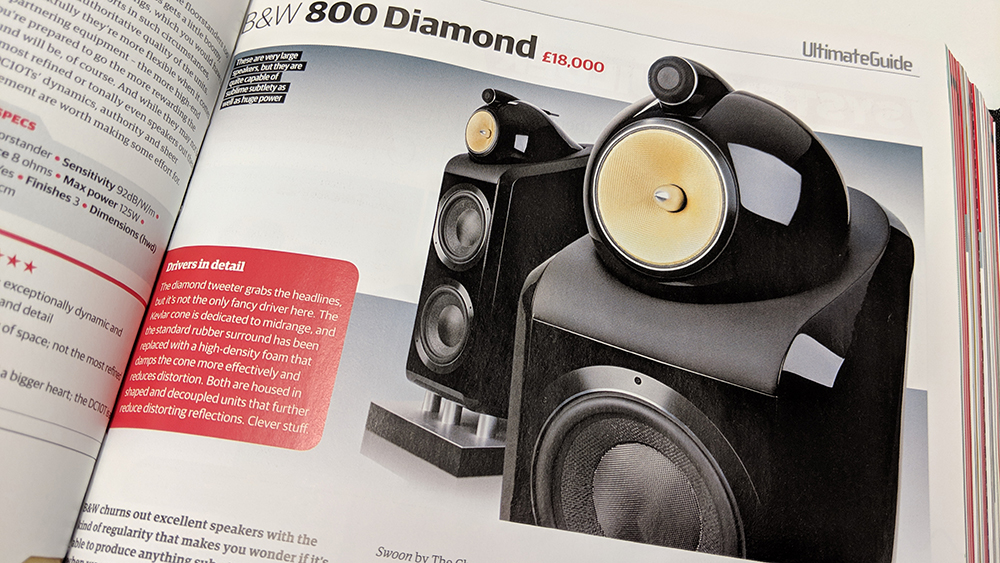
If you've got £18,000 to spend on a pair of speakers (you lucky thing), you should very much consider spending it on the B&W 800 Diamonds; "the best speaker B&W makes", as we called them back in September 2013. If you need to club together with a few friends for that sort of money, that might be no bad thing; just moving one of these 102kg speakers into place is a four-person job, standing as they do, 118cm tall, 45cm wide and 65cm deep. "Innovative technology and great sound don’t always go hand in hand. In the 800s’ case they do." The company’s best speakers, yes. The best speakers bar none? Quite possibly.
Read the full B&W 800 Diamond review
B&W 685 S2
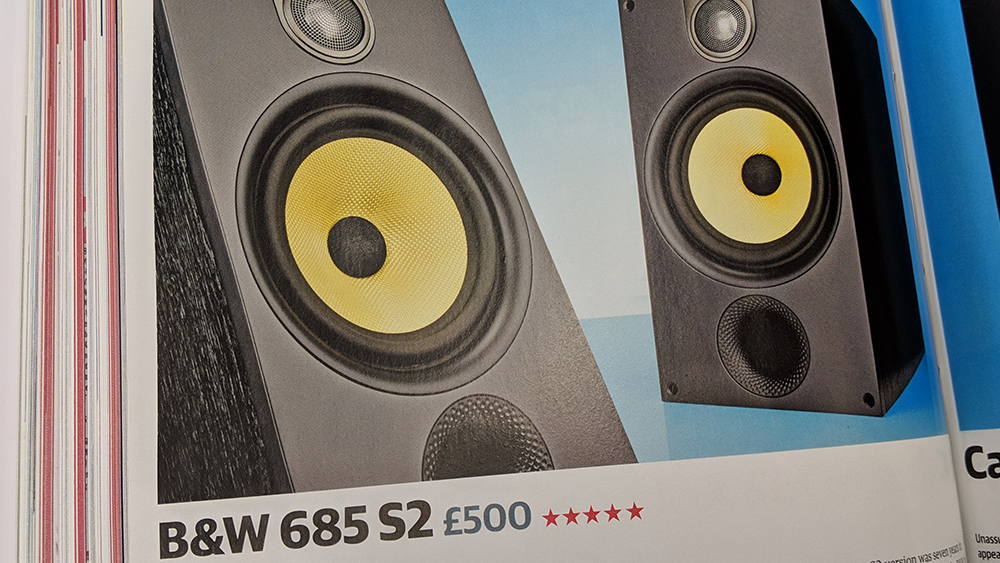
You'd be hard-pressed to find a more competitive product category than £500 bookshelf speakers. So standing out and dominating over a period of a few years takes some doing. But that's just what the 685 S2 speakers did following their launch in 2014. It was perhaps no surprise considering the quality of their forebears, the original 685s. As well as the now very familiar Kevlar mid/bass cone, the S2s had a metal grille over the tweeter, aiding dispersion and adding a degree of protection. The tweeter itself had been made more rigid and decoupled from the cabinet. Crucially, the sound produced was powerful and muscular, with deep bass and lashings of detail. And they proved very popular.
Read the full B&W 685 S2 review
B&W 805 D3
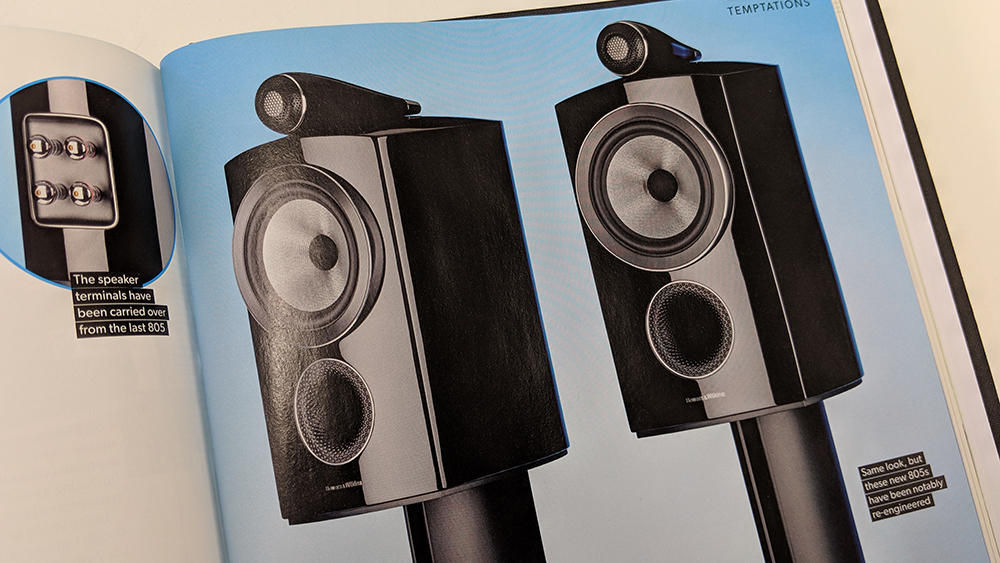
Another addition to the B&W Diamond range, the 805 D3s brought with them some not insignificant changes to B&W's already highly-successful high-end range. The diamond-dome tweeter was completely overhauled, while more jaw-droppingly for B&W nuts, the Kevlar mid/bass driver was replaced by a new Continuum cone.
Developed in-house, the Continuum material aimed to take the key properties of Kevlar - good self-damping and low mass - and take them to the next level. It was cost-effective, too, so would soon find its way in to far more affordable speakers. "Polished Diamond is an absolute gem," was our June 2017 verdict, thanks to great detail resolution, incisive stereo imaging and that tip-top build and design.
Read the full B&W 805 D3 review
B&W 606 S2 Anniversary Edition

Bringing B&W, and British hi-fi, right up to date, we have the excellent the B&W 606 S2 Anniversary Edition speakers, which appear in our December 2020 issue. They represent 25 years and seven generations of the hugely successful 600 series standmount speaker line.
They use the company's now favoured Continuum cone – here in a 16.5cm driver – sport a 25mm, decoupled double-dome aluminium tweeter, and have B&W's Flowport vent. A smart, minimalist styling has replaced the more striking designs of the 90s and 00s, but the so often class-leading sound quality remains.
On paper, there wasn't much change between this edition and the Award-winning 606s from 2019: some attractive cosmetics and an upgraded crossover, featuring better-quality capacitors but small tweaks can make big differences.
The 606 S2 Anniversary Editions prove significantly more capable than their predecessors. With precise, controlled bass; a brilliantly balanced, clean sound; and more insight, punch and downright entertainment than ever before, they remain the speakers to beat at around the £500 mark. Stop them if you can.
Read the full B&W 606 S2 Anniversary Edition review
Bowers and Wilkins P9 Signature

Turning 50 is a big deal for any company, and Bowers and Wilkins celebrated its big day with a splash, launching a wealth of special edition products. The coolest and one the team loved the most, however, was the B&W P9 Signature.
Featuring a classy brown leather finish they sit in the same special edition class as the Signature Diamond and the Signature 30 speakers. Despite this, the headphones were completely built from scratch featuring a design and parts you couldn’t get anywhere else.
While they cost a pretty penny at the time, being twice the price of the base non-Signature model they justified this with best in class audio delivering stunning midrange clarity, superb detail levels, weighty, agile bass and a generally precise but exciting character. All that combines to make them one of the most iconic B&W products ever made.
Read our B&W P9 Signature review
B&W Pi8
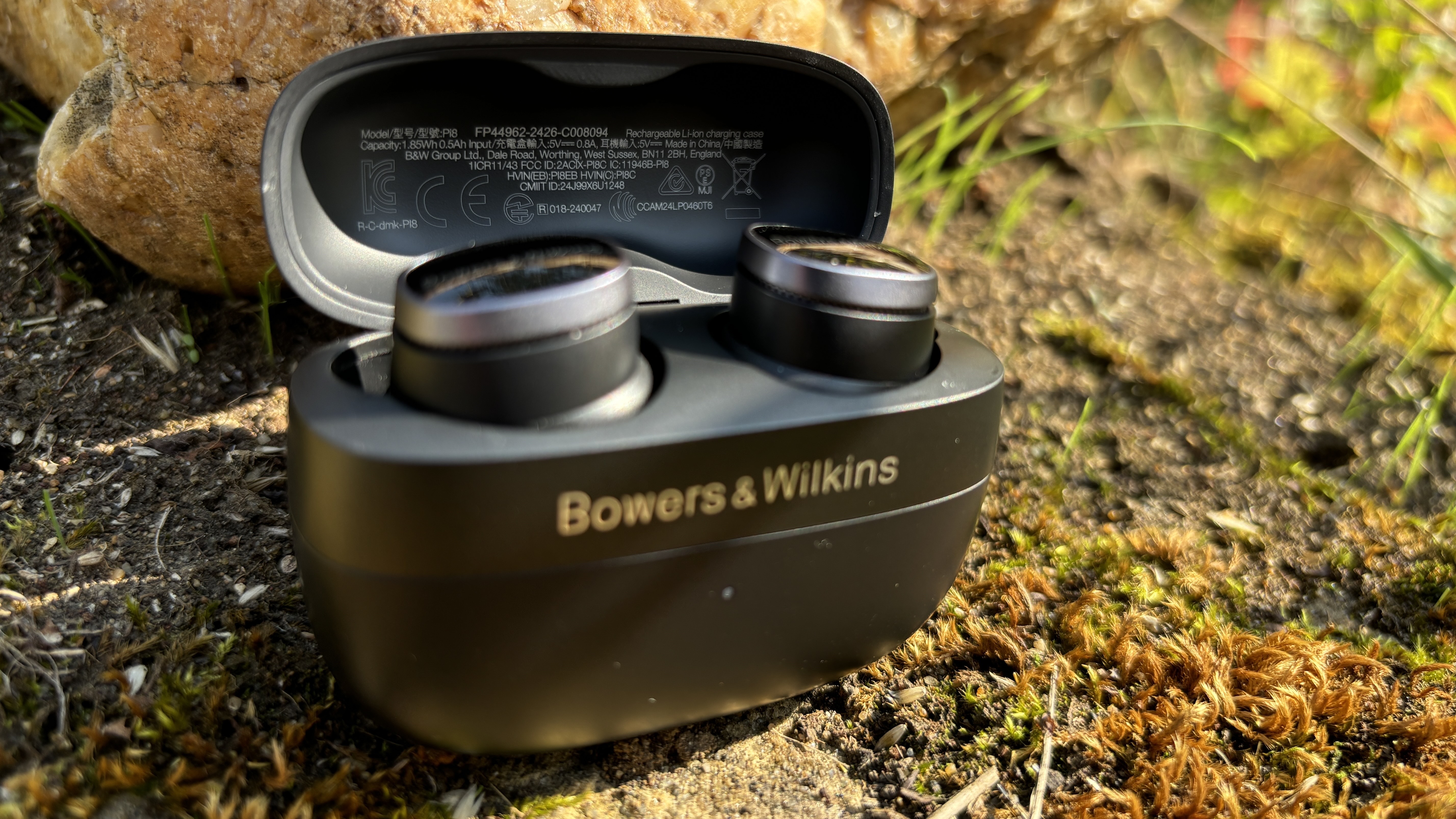
Wireless earbuds are a tricky nut to crack for many audio shops with their small form factor, the complexities of wireless connectivity and strong competition making them hard to get just right. But, after slightly missing the mark with its opening B&W Pi7 and B&W Pi7 S2 buds, Bowers and Wilkins did just that with its B&W Pi8.
Though they were more expensive than most rivals at launch, when we got them in for testing they more than justified the additional cost. The buds were built by the same in-house engineering team that gave us the Px7 S2 and Px8 over-ear, wireless headphones. They share a lot of the same perks as a result.
Featuring a premium, but compact design, stellar battery life, reliable ANC and most important sensational audio, they’re easily the best wireless earbuds Bowers and Wilkins has ever made. Hence their inclusion in this list.
Read our Bowers and Wilkins Pi8 review

Joe is the Content Director for What Hi-Fi? and Future’s Product Testing, having previously been the Global Editor-in-Chief of What Hi-Fi?. He has worked on What Hi-Fi? across the print magazine and website for almost 20 years, writing news, reviews and features on everything from turntables to TVs, headphones to hi-fi separates. He has covered product launch events across the world, from Apple to Technics, Sony and Samsung; reported from CES, the Bristol Show, and Munich High End for many years; and written for sites such as the BBC, Stuff and The Guardian. In his spare time, he enjoys expanding his vinyl collection and cycling (not at the same time).
